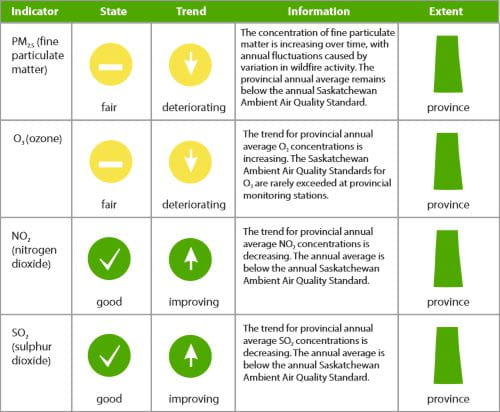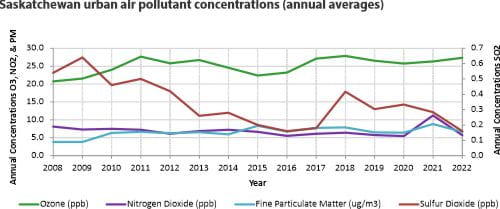
Why we measure this
The Ministry of Environment monitors ambient air quality in Saskatchewan. The concentration of various air pollutants is measured to ensure Saskatchewan has a healthy and resilient environment.
Measuring and evaluating the concentration of air pollution across Saskatchewan is a vital activity. These measurements provide the public with real time air quality information and the government with long-term trends, making it easier to identify and track changes in our environment.
What is happening

Air quality across Saskatchewan is generally low risk to human health. Average pollution levels for most parameters have been dropping over time. Sulphur dioxide (SO2) and nitrogen dioxide (NO2) levels declined between 2000 to 2022.
Fine particulate matter (FPM or PM2.5), defined as airborne particles less than 2.5 micrometres in diameter, has been increasing slightly since 2010. This is mostly due to the impacts of wildfire smoke. These fires are considered exceptional events and cause a short-term reduction in air quality.
The improvements we have seen in Saskatchewan's overall air quality do not extend to ozone (O3). Ozone levels continue to increase, despite the reduction in pollution concentrations that contribute to ozone formation. Several reasons could explain this, including a rise in average background ozone concentrations and cross-border impacts. Background ozone includes naturally occurring ozone. The formation of ozone is complex and is dependent on a chemical reaction involving NOX and hydrocarbons in the presence of sunlight. When there is less NOX in the air, it can result in ozone levels remaining high and may even increase in concentration.

What we are doing
Saskatchewan is committed to the Air Quality Management System established by the Canadian Council of Ministers of the Environment. This system is a national approach to managing air quality in Canada. The driver of the system is the Canadian Ambient Air Quality Standards, which are federal standards developed to protect human health and the environment. Saskatchewan contributes to the system by reporting on the federal goals and developing plans to assign progressively more rigorous actions to prevent air quality deterioration, as the air quality comes closer to exceeding the federal standards.
As part of the system, Saskatchewan has identified six air zones, which are areas that exhibit similar air quality characteristics, issues and trends. These air zones form the basis for monitoring, reporting and taking action on air quality issues. Saskatchewan will continue to improve its collaborative efforts with the air zone associations to review trends and assess air quality issues.
The Ministry of Environment operates six ambient air monitoring stations, one in each air zone, under the National Air Pollution Surveillance (NAPS) Program. Continuous air quality monitoring takes place in six locations across our province: Regina, Saskatoon, Prince Albert, Swift Current, Estevan and Buffalo Narrows. NAPS is jointly operated and maintained by the provinces, territories and Environment and Climate Change Canada. The NAPS ambient air monitoring program is operated by the provincial government in Saskatchewan and provides accurate, long-term air quality data. Real time information from these monitoring sites is available to the public.
Air zone associations have been established in three of the six air zones, where higher industrial activity and population density are found: Southeast Saskatchewan Airshed Association, Western Yellowhead Air Management Zone and Great Plains Air Zone. These associations provide additional monitoring in areas not monitored by the provincial monitoring program. For more information on air zone management in Saskatchewan, please view the latest Air Zones Report.
Saskatchewan also has two mobile air quality stations used to supplement the continuous monitoring network. The Mobile Air Quality Station and the Rapid-deployment Air Quality Station are specially designed trailers equipped to supplement the ministry's air monitoring capabilities anywhere in the province accessible by road.

